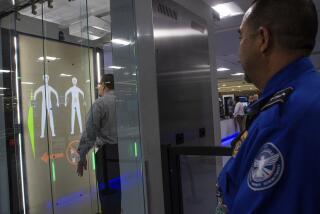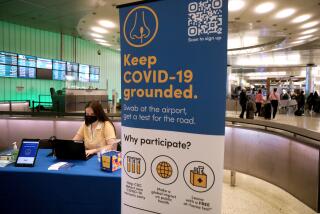First bags, now passengers?
- Share via
Airline passengers could soon be screened much the way their carry-on baggage is screened -- by X-ray.
As part of its antiterrorism effort, the federal government is considering a plan to install X-ray machines in airports to scan outgoing passengers. The technology is used in prisons and by U.S. Customs and Border Protection agents to search for drugs, illegal weapons and contraband.
But the idea of using it on 700 million American air passengers a year is generating privacy concerns from civil libertarians -- and safety questions among scientists, who question whether the risks, however small, outweigh the potential benefit of catching people with plastic explosives or other dangerous devices.
Citing research from three organizations of radiation specialists, the manufacturer of one device, BodySearch, said the technology was safe, even for children and pregnant women.
The National Council on Radiation Protection and Measurements, a nonprofit corporation chartered by Congress, concluded that the technology was not dangerous because it used very low-dose “backscatter” X-rays.
In medical X-rays, the rays go all the way through the body and land on film or are digitized to produce an image; in “backscatter” imaging, the X-rays bounce back toward the scanner, with only shallow penetration of the body, and produce ghostly images of the body in its naked glory -- love handles, underwire bras, private parts and all.
For most people, even for frequent fliers, this low exposure is probably safe -- it would take at least 2,500 scans a year to reach the maximum recommended exposure. (Security personnel would not be exposed unless they were scanned by the machines.)
As long as the X-ray machine is maintained properly, the dose from one scan would be about 1,000th as much as a traditional chest X-ray. That’s “barely measurable,” said Dr. Elliot Fishman, a radiologist at Johns Hopkins Hospital.
In fact, it’s less than the background radiation from the cosmic rays that you get from flying cross-country, far less than a dental X-ray; hundreds of thousands of times less than a whole body CT scan; and millions and millions of times less than X-rays used to treat, say, prostate cancer.
But -- and this is a big “but” -- some people might be at extra risk of radiation-induced problems.
Even though the risk is “minuscule,” said Lee Chin, chief of medical physics at the Dana-Farber Cancer Institute and Brigham and Women’s Hospital, “there may be a finite risk when such a large population is irradiated.”
Furthermore, people at extra risk may not know who they are, said David Brenner, professor of radiation oncology and public health at Columbia University Medical Center. The biggest radiosensitive group is children and fetuses. “I would be uncomfortable in a scenario where pregnant women were forced to go through these machines,” he said, adding that “women don’t always know if they’re pregnant.”
Others may be extra radiosensitive too, including people who carry the breast cancer genes called BRCA1 and BRCA2, who may not know they have the genes. And an even bigger risk group is people who unknowingly carry a mutated gene called ATM (for ataxia-telangiectasia).
David Albright, a physicist and president of the Washington, D.C.- based Institute for Science and International Security, a nonprofit, nonpartisan science policy group, said, “If hundreds of millions of people are scanned with this device each year, the population dose could reach levels where a few cancers are possible. Even if just one person died, is that worth it?”
Balancing these trade-offs is difficult and fraught with emotion.
Because “no dose of radiation is without some risk,” said Dr. Jay Harris, chairman of the department of radiation oncology at Dana-Farber and Brigham, “the benefit of possibly catching terrorists must be weighed against the risk to the public and the feasibility of alternative methods.”
David Ropeik, director of risk communication at the Harvard Center for Risk Analysis, said that radiation was hard to understand, in part because it is invisible. And people tend to worry more about hazards they don’t understand or can’t see. Moreover, “any risk imposed on you feels scarier than a risk you choose yourself,” he said.
Others see it differently.
“I would welcome the fact that I am safer” because the X-rays would make it harder for terrorists to smuggle bomb-making material onto planes, said Chris Cagnon, a clinical medical physicist at the David Geffen School of Medicine at UCLA.
But what would happen, he wondered, if people began outsmarting the technology? “It would be easy for people to start wearing clothes that are hard to X-ray. If so, then, what’s the point?”
And the fact that radiation experts have deemed the idea safe does not convince George J. Annas, chairman of the department of health law, bioethics and human rights at the Boston University School of Public Health. “Physicists love radiation,” he said. Low doses? “They always say that.”
So far, the Transportation Security Administration, part of the Department of Homeland Security, is merely “contemplating initiating a pilot program” to test the machines at airports, said spokeswoman Yolanda Clark.
More to Read
Sign up for Essential California
The most important California stories and recommendations in your inbox every morning.
You may occasionally receive promotional content from the Los Angeles Times.













